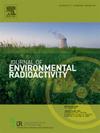Effect of different Prussian Blue compounds in feed on 137Cs uptake and excretion by silver Prussian carp
IF 2.1
3区 环境科学与生态学
Q3 ENVIRONMENTAL SCIENCES
引用次数: 0
Abstract
This paper documents that adding different hexacyanoferrate compounds, commonly referred to as Prussian Blue (PB), to feed is an effective and inexpensive countermeasure to reduce contamination of fish with 137Cs. Laboratory aquarium experiments were conducted to investigate the effects of feed containing either 0.1 % or 1 % ammonium ferric hexacyanoferrate (AFCF, NH4Fe [Fe(CN)6]), potassium ferric hexacyanoferrate (KFCF, KFe [Fe(CN)6]), or Ferrocyn (mixture of 95 % ferric hexacyanoferrate (FCF, Fe4 [Fe(CN)6]3) and 5 % KFCF) on the uptake and excretion of 137Cs by silver Prussian carp (Carassius gibelio (Bloch, 1782)). The experiments lasted for 2 months at a constant water temperature of 24 ± 2 °C. In each aquarium, at 9 a.m., fish received 0.2 g of feed per day (about 0.2 % of fish weight) containing 19 ± 2 Bq of 137Cs. In addition, at 3–4 p.m., fish in different aquariums received 0.8–1.0 g of feed (about 1 % day−1) containing 0 %, 0.1 % or 1 % of different PB compounds. The use of feed with 0.1 % and 1 % of PB compounds resulted in a 1.8–2.1 and 2.2–2.8-fold decrease in 137Cs in the fish body compared to the control group of fish receiving feed without PB compounds after one month of the experiment and a 2.3–3.0 and 2.8–3.7 decrease after two months (at the end of the experiments). The reduction factors when using PB compounds can reach maximum values, 5–10, when 137Cs activities in the treated and control groups of fish reach the maximum (stable) levels. The method of feed granulation, dry or wet, did not affect the effectiveness of PB, and no statistically significant differences were found between the efficiencies of the studied PB compounds.
The results obtained, along with the results of our previous studies, demonstrate that, unlike in mammals, the use of PB compounds in feed does not significantly reduce the resorption of radiocesium in the gut (by 1.4–1.8 times), but substantially reduces the effective half-life of 137Cs activity in fish (from 100 to 16–28 days).
饲料中不同普鲁士蓝化合物对普鲁士银鲤吸收和排泄137Cs的影响
在饲料中添加不同的六氰高铁酸盐化合物(通常称为普鲁士蓝(PB))是一种有效且廉价的降低鱼类受137Cs污染的对策。通过室内水缸试验,研究了0.1%或1%六氰高铁铵(AFCF, NH4Fe [Fe(CN)6])、六氰高铁钾(KFCF, KFe [Fe(CN)6])或铁素(95%六氰高铁(FCF, Fe4 [Fe(CN)6]3)和5% KFCF的混合物)对银鲫(Carassius gibelio, Bloch, 1782)对137Cs的吸收和排泄的影响。实验持续2个月,恒温水温为24±2℃。在每个水族箱,上午9点,鱼每天接受0.2 g饲料(约占鱼重的0.2%),饲料中含有19±2 Bq的137Cs。此外,在下午3点至4点,不同水族馆的鱼接受了0.8-1.0 g含有0%、0.1%或1%不同PB化合物的饲料(约1% day - 1)。试验1个月后,添加0.1%和1% PB化合物的饲料与不添加PB化合物的对照组相比,鱼体内137Cs含量分别下降1.8-2.1和2.2 - 2.8倍,2个月后(试验结束时)分别下降2.3-3.0和2.8-3.7倍。当处理组和对照组137Cs活性达到最大(稳定)水平时,使用PB化合物的还原因子达到最大值5 ~ 10。饲料造粒方式(干法和湿法)均不影响铅的有效性,所研究的铅化合物之间的效率无统计学差异。本研究结果以及我们之前的研究结果表明,与哺乳动物不同,饲料中添加PB化合物并没有显著减少鱼类肠道对放射性铯的吸收(减少1.4-1.8倍),但却大大降低了鱼类体内137Cs活性的有效半衰期(从100天减少到16-28天)。
本文章由计算机程序翻译,如有差异,请以英文原文为准。
求助全文
约1分钟内获得全文
求助全文
来源期刊

Journal of environmental radioactivity
环境科学-环境科学
CiteScore
4.70
自引率
13.00%
发文量
209
审稿时长
73 days
期刊介绍:
The Journal of Environmental Radioactivity provides a coherent international forum for publication of original research or review papers on any aspect of the occurrence of radioactivity in natural systems.
Relevant subject areas range from applications of environmental radionuclides as mechanistic or timescale tracers of natural processes to assessments of the radioecological or radiological effects of ambient radioactivity. Papers deal with naturally occurring nuclides or with those created and released by man through nuclear weapons manufacture and testing, energy production, fuel-cycle technology, etc. Reports on radioactivity in the oceans, sediments, rivers, lakes, groundwaters, soils, atmosphere and all divisions of the biosphere are welcomed, but these should not simply be of a monitoring nature unless the data are particularly innovative.
 求助内容:
求助内容: 应助结果提醒方式:
应助结果提醒方式:


